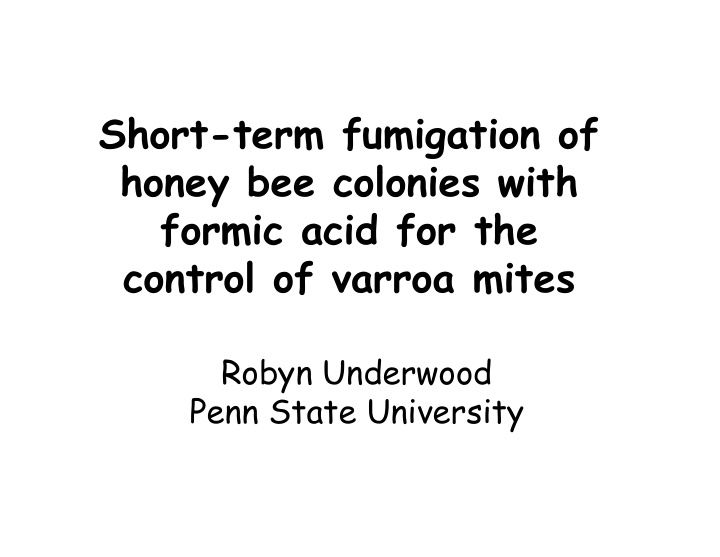



Short-term fumigation of h honey bee colonies with b l i ith formic acid for the formic acid for the control of varroa mites Robyn Underwood Robyn Underwood Penn State University
Formic Acid Formic Acid � Controls varroa mites and tracheal mites � No resistance � No residues � Depends on temperature � No application during honey flow
Honey flow Honey flow
Varroa mites Varroa mites David Ostermann Immatures Adult female Robyn Underwood
Treatment Treatment � Late September � No treatment � Low dose gel pack � Low dose gel pack � (with or without oxalic acid in January) � Hi h d � High dose gel pack l k � (with or without oxalic acid in January)
Formic acid gel pack Formic acid gel pack
Mite Drop (Sep vs Oct ) Mite Drop (Sep. vs. Oct.) Before After 80 70 y ling per day 60 50 r of mites fal 40 30 Number 20 10 0 Control Low High Treatment
Mean Abundance (Sep. vs. Oct.) Mean Abundance (Sep vs Oct ) S Sept t Oct 20 18 16 0 Bees 14 12 Mites per 100 10 8 No. M 6 6 4 2 0 Control Low High Treatment
Oxalic Acid - January Oxalic Acid - January
Mite Drop (OA treatment) Mite Drop (OA treatment) Control LowNO 200 LowOx HighNO 180 HighOx 160 160 y alling per day 140 120 er of mites fa 100 80 60 Numbe 40 20 0 0 Before Ox. 2-day Ox. Next 5 days Next 7 days Sampling period
Spring Spring
Mean Abundance Mean Abundance Fall Spring 26 24 22 20 0 Bees 18 16 * * Mites per 100 14 * 12 10 8 No. M 6 4 2 0 0 Control SmallNO SmallOx LargeNO LargeOx Treatment
Brood Area Brood Area Control LowNoOxalic 3.5 LowOxalic HighNoOxalic 3.0 HighOxalic 2.5 f brood 2.0 o. frames of 1.5 1 0 1.0 N 0.5 0.0 Fall After FA trt Spring Time
Colony Survival Colony Survival 1 0 1.0 Dead 0.9 Alive 0.8 0.7 n Alive 0.6 0.5 0 5 Proportio 0.4 0.3 0.2 0.1 0 0 0.0 Control LowNO LowOx HighNO HighOx Treatment
Conclusions Conclusions � FA treatment did not affect mean abundance � Oxalic acid decreased mean abundance � Oxalic acid decreased mean abundance � Brood area not affected � C l � Colony survival poor overall i l ll
Acknow ledgments Acknow ledgments � Jim Steinhauer, Tiffany Crum, Marcus Dennis, Glenn Crimbring, Mary Snow, Craig Cella, Henry Street Paul Krepicz Mike Thomas Rene Street, Paul Krepicz, Mike Thomas, Rene Troutman, Dennis Keeney, Sharon McDonald, Linda Wertz, Karen Roccasecca, Amber Lamons, Mike Andree Mik A d � Nancy Ostiguy, James Stimmel � N ti � National Honey Board l H B d � Zane Helsel, Rutgers University
Recommend
More recommend